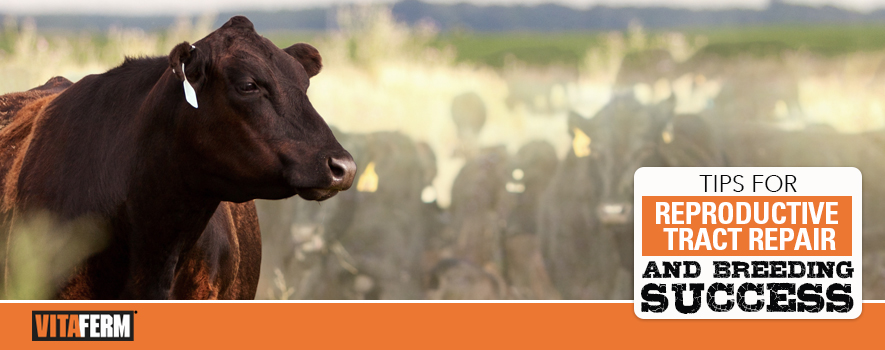
A brood cow is the heart of the herd. She is the one that lays down each year to have a calf to ultimately propagate her outstanding genetics or help feed the world. And even though her role is considered important by all those around her, being a cow is not always a glamorous job.
Once that heifer is bred, endures gestation and delivers her first calf, she has experienced perhaps the most stressful time in her life since weaning. Now, she is lactating, raising her calf, still growing all while healing her reproductive tract. And, typically within 60 days of delivering that calf, she’s expected to be ready for rebreeding, which is why taking care of her reproductive health is of the upmost importance.
“The most important trait in beef production is reproduction. If those cows are not breeding back and giving you a calf every year, you’re not going to be profitable. The reproductive tract is the epicenter of reproductive efficiency,” said Lindsey Grimes-Hall, Nutrition & Field Sales Support for BioZyme® Inc.
The reproductive tract endures a lot of stress during the last days of gestation and calving. There are some factors you should consider to ensure your cows stay in good reproductive shape.
- Mating Decisions. When selecting bulls to breed your females to, consider size and age of the females. Are you breeding first-calf heifers or even rebreeding cows for their second calf? Remember, they are still growing and maturing themselves, and most two to three-year-old cows have a smaller reproductive tract and pelvis than mature cows. When making mating decisions, choose lower-birthweight bulls with a more desirable calving ease. Therefore, the younger cows should have smaller calves that won’t rip or tear the reproductive tract as much as a larger calf or one you have to assist. Most mature cows can lay down and have a larger calf unassisted.
Calves with higher birthweights will increase chances of dystocia, taking her longer to bounce back.
- Don’t Rush. Try to let your cows have their calves on their own and don’t rush into pulling a calf, for the sake of pulling a calf. Maybe you’ve just conducted your 11 p.m. check, and notice there’s a cow in the early stages of labor. She’s an older cow that’s never had challenges calving before; however, it is late, and you’re tired. Don’t put her in and pull her calf, as that can cause unnecessary tears and rips, taking longer to heal. Let the cow take her time and go back to check on her in an hour or so.
- Supply Adequate Nutrition. The one thing producers can offer their cows to maintain optimal reproductive health of the cows is providing good nutrition all year long.
“There are so many external factors that can influence reproduction that are out of our control,” Grimes-Hall said. “Weather is a big one. Genetics is another. Almost anything can influence reproduction, but nutrition is the one thing we can control, so why not set her up for the best chance possible with a good plane of nutrition? You can do a lot from a year-round nutrition standpoint.”
The first thing a producer should do is make sure the cows are in proper body condition. Typically, you’d want your cows to have a BCS of 5-6 prior to calving. Make sure your cows are not too fleshy. Cows that are overly conditioned can increase your incidences of dystocia, resulting in harder pulls, which makes cleaning up and recovery harder on the cow. On the extreme side, make sure your cows aren’t undernourished either.
“If your cow is too skinny, she will crash trying to have that calf. She must have adequate energy to meet her nutrient requirements and those of that growing calf,” Grimes-Hall said.
Perhaps the most important thing you can do for your cows’ reproductive health throughout the year is make sure they are on a high-quality mineral program like the Vitaferm® Concept•Aid® line of vitamin and mineral supplements for beef cattle formulated to promote effective, easy breeding when fed 60 days pre-calving through 60 days post-breeding. High concentrations of vitamin E and organic trace minerals, combined with the Amaferm® advantage, supports quick repair of the reproductive tract and more energy for reproductive success.
“Calving is a huge trauma to the reproductive tract, so the high fortification of the trace minerals and vitamin E for cell integrity and muscle repair all have a huge impact on the cow’s reproductive health, Grimes-Hall said. “Additionally, Amaferm is research-proven to initiate and maintain pregnancy.”
Amaferm®️ is a prebiotic designed to enhance digestibility by amplifying the nutrient supply for maximum performance. It is research-proven to increase intake, digestion and absorption. In addition to Amaferm, and vitamin E, Concept•Aid contains organic copper, zinc and manganese to ensure maximum bioavailability of nutrients to the animal. These minerals have a huge impact on the reproductive tract and hormone production. A final key ingredient is iodine, which aids in thyroid hormone synthesis, which also impacts reproduction.
When you expect the most from your cows, it’s imperative to provide them with the best care possible. A high-quality mineral program coupled with best management practices will ensure reproductive performance that delivers.


